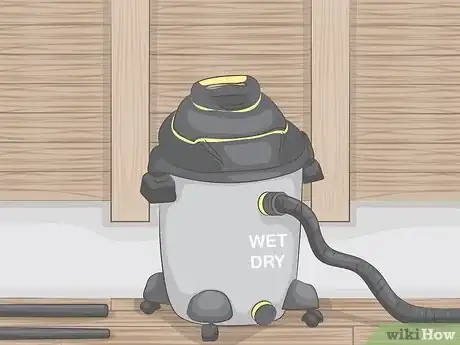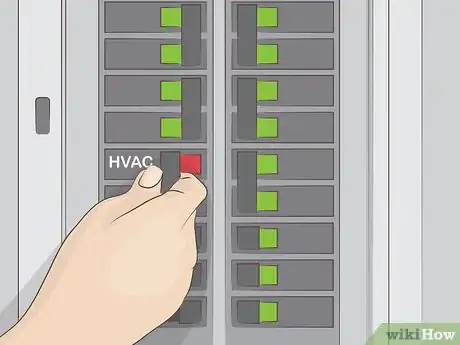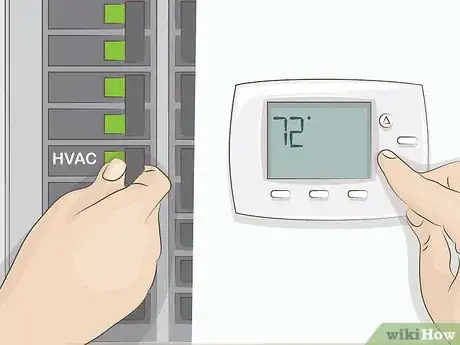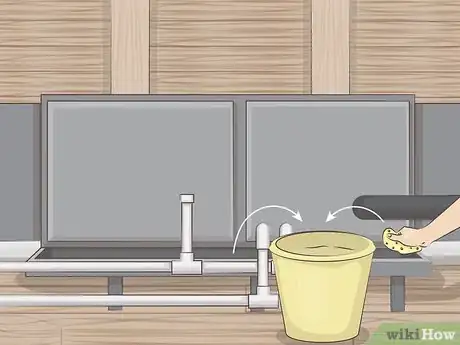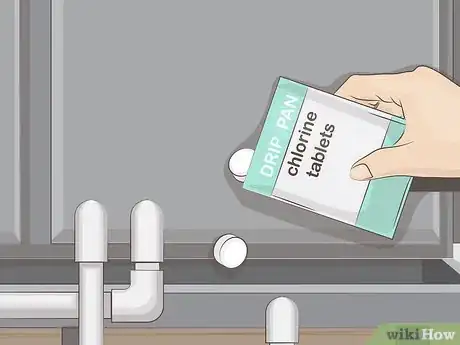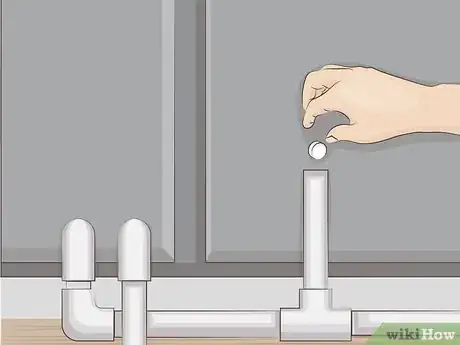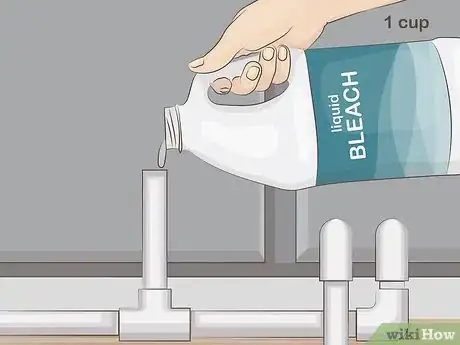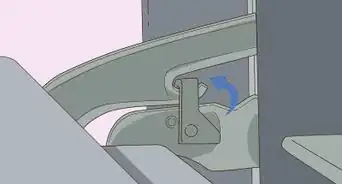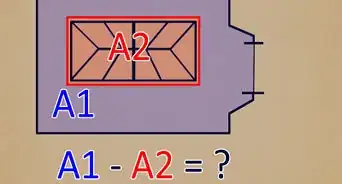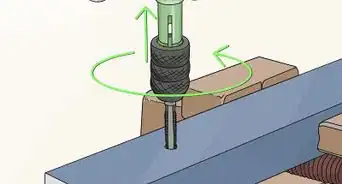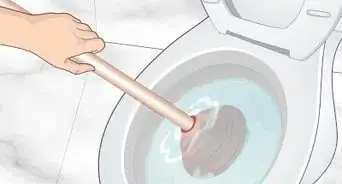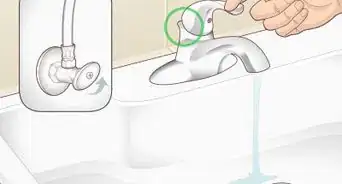This article was co-authored by Victor Belavus. Victor Belavus is an Air Conditioning Specialist and the Owner of 212 HVAC, an air condition repair and installation company based in Brooklyn, New York. In addition to HVAC and air conditioning units, Victor also specializes in furnace repair and air duct cleaning. He has over 10 years of experience working with HVAC systems.
There are 8 references cited in this article, which can be found at the bottom of the page.
This article has been viewed 49,475 times.
A clog in the drain line of an attic AC unit is a homeowner’s worst nightmare. It can potentially cause extensive and expensive water damage. Luckily, it is usually easy to clear out a clog. A powerful wet/dry vac and proper hose attachment can take care of most jobs. You can also help prevent clogs from occurring in the future. Just treat your AC system’s drain lines with chlorine tablets or bleach at least once a year.
Steps
Clearing Out a Clog
-
1Buy or rent a wet/dry vac with attachments if you don’t have one. To clear out your clog, you can use a standard wet/dry vac with a 10–12 US gal (38–45 L) tank. Make sure you also have an attachment that will connect the wet/dry vac to the drain line. An attachment with a 3⁄4 in (1.9 cm) opening should work well.[1]
- If you don’t own a wet/dry vac, you can rent one from most large home improvement stores, or purchase one for anywhere between $25 and $550.
- More expensive models are designed for heavy use by contractors and home renovators. For a job like unclogging an AC drain line, a cheaper model should work well enough.
-
2Turn off power to your AC unit at your fuse box. Your fuse box may be in your garage, your basement, a storage room, or a hallway. It is a metal box, usually flush with the wall. Open the panel and look for a switch labeled “HVAC.”[2]
- If you cannot find the correct switch, turn on the AC system’s fan at your thermostat. Then flip switches in your fuse box one by one until you find one that turns the fan off.
Advertisement -
3Find the condensate drain line and drain line access point. Look for white PVC pipe around 3⁄4 inch (1.9 cm) in diameter coming out of your AC system’s indoor unit. Most, but not all, AC units will have an easy-to-locate access point to the drain line. Look for an upside-down or sideways “T” shape of PVC pipe with a removable cap.[3]
- Alternatively, you can find where the condensate line exits your house. Look for a PVC pipe, approximately 3⁄4 in (1.9 cm) in diameter, poking out of your house’s exterior wall. It will most likely be located near the outside unit of your AC system.[4]
- If you’re having trouble finding the access point to the drain line, refer to the owner’s manual for your particular AC unit.
-
4Use the suction hose of a wet/dry vac to suck the clog out. Remove the cap from the condensate drain line. Fix the hose attachment to the wet/dry vac’s hose, and position it into or flush with the end of the drain line. Then, use duct tape to seal the gap between the hose and the drain line. Once everything’s connected, turn on the wet/dry vac and let it run for about 3 minutes.[5]
- Experiment with different hose attachments to see which one will give you the strongest suction. Hose attachments that fit in or around the end of the condensate drain line with the smallest gap will work best.[6]
- Before starting the wet/dry vac, remove its paper air filter, so it doesn’t get ruined.[7]
- Alternatively, use an AC drain brush and CO2 drain gun to remove the clog.
-
5Disconnect the attachment and empty the wet/dry vac’s tank. Once you’ve sucked the clog out of your drain line, disconnect the attachment from the drain line. Then unplug the wet/dry vac. Remove the lid and the hose, and empty the liquid in the tank into a suitable drain, such as one located in your garage.[8]
- To determine if you’ve sucked the clog out of the drain line, open your wet/dry vac so you can see the inside of the tank. If you’ve successfully sucked out the clog, you will see solid chunks of mold and mildew in the tank. If you don’t see this, reattach the hose to the drain line and try again.
- If your wet/dry vac has a drain located at the bottom of its tank, simply position your tank over a household drain and unscrew the cap.
-
6Check to see if your AC unit is working properly. Once you’ve sucked out the clog with your wet/dry vac, be sure to reattach the cap you removed from the AC drain line. Then, turn the power to your AC unit back on.[9]
- Monitor the drain line of your AC unit over the next several days and weeks to make sure water is draining properly.
Preventing Clogs in Your AC Drain
-
1Empty any standing water in the AC drain pan manually. If your AC system has a drain pan, check it regularly to see if there’s any standing water. Emptying standing water from the drain pan on a regular basis will help prevent the growth of algae, which is one of the major causes of clogs in AC drains.[10]
- Remove any debris from the drain pan on a regular basis, as well.
- Empty your drain pan daily during warm-weather months if there’s standing water.
-
2Use condensate pan tablets to prevent drain clogs. Place chlorine tablets in your drip pan to prevent the growth of algae. Buy chlorine tablets that are designed to be used in AC condensation drain pans. Follow the directions listed on the package for how many tablets to use and how often you should add them to your system.[11]
- You can purchase these tablets at most major retailers and home improvement stores.
- The tablets in the drain pan will treat the water before it flows into the condensation drain line, helping to prevent the growth of slime and sludge inside the drain line.
- You may need to add tablets as frequently as every month.
-
3Insert chlorine tablets directly into the drain line if there’s no drain pan. Find the drain lines running out of the indoor unit of your AC system. Then find the access pipe, which should look like an upside-down “T.” Unscrew the cap on the pipe and drop in the tablets.[12]
- Follow the directions printed on the package of the specific tablets you purchase.
- A lot of algae build-up occurs during cool-weather months when you don’t use your air conditioner, when there’s no steady flow of water running through the lines.
-
4Pour 1 cup (240 mL) liquid bleach into the line as a cheaper alternative. Pour the bleach into the access pipe at the top of the drain line. Flush your line with bleach once a year, or every 2-3 months if you live in an humid environment.[13]
- Since bleach is a liquid, it won’t work quite as effectively as the chlorine tablets, which dissolve gradually and coat the inside of the drain line.
Things You’ll Need
Clearing Out a Clog
- Wet/dry vac
- Wet/dry vac attachment with a 3⁄4 in (1.9 cm) opening
- Duct tape
Preventing Clogs in Your AC Drain
- Chlorine tablets (option 1)
- Household bleach (option 2)
References
- ↑ https://youtu.be/HyvPR7yMqbk?t=58
- ↑ https://youtu.be/bDVLkMTDVL8?t=28
- ↑ https://www.myfrugalhome.com/how-to-clean-a-clogged-ac-condensate-drain-line/#comments
- ↑ https://youtu.be/HyvPR7yMqbk?t=33
- ↑ https://youtu.be/xVvxMIK5RBY?t=49
- ↑ https://www.myfrugalhome.com/how-to-clean-a-clogged-ac-condensate-drain-line/
- ↑ https://www.popularmechanics.com/home/how-to/a7782/quick-fixes-for-leaky-ac-systems-8925561/
- ↑ https://youtu.be/RNwKkz09xEc?t=17
- ↑ https://www.myfrugalhome.com/how-to-clean-a-clogged-ac-condensate-drain-line/
- ↑ https://www.popularmechanics.com/home/how-to/a7782/quick-fixes-for-leaky-ac-systems-8925561/
- ↑ https://www.popularmechanics.com/home/how-to/a7782/quick-fixes-for-leaky-ac-systems-8925561/
- ↑ https://www.popularmechanics.com/home/how-to/a7782/quick-fixes-for-leaky-ac-systems-8925561/
- ↑ https://www.popularmechanics.com/home/how-to/a7782/quick-fixes-for-leaky-ac-systems-8925561/
